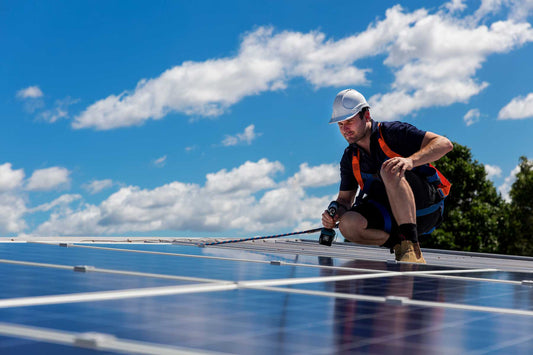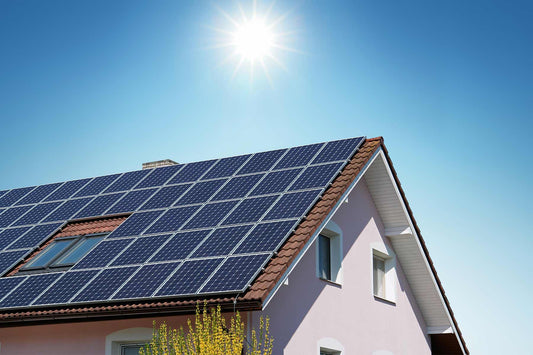Solar panel cells are made of semiconductor materials that generate an electric field when they absorb sunlight. This electric current is then channeled using wires to power electronics.
Everyone knows that the sun is powerful — stand outside for a couple minutes on a sunny day and you'll feel its rays from over 90 million miles away. But how do we capture those rays and turn them into electricity? More specifically, how do solar panels work?
In this guide we'll unpack how solar panels work, demystifying concepts like the photovoltaic effect, so that you can better understand the tech behind harnessing solar energy.
What Is Solar Energy?
Let's start with the basics. Solar energy refers to energy from the sun's rays that can be captured and converted into other forms of energy, like thermal or electrical. Since the sun is nowhere close to dying, solar energy is considered sustainable and renewable.
Unfortunately, not every part of the Earth receives the same amount of solar energy. That said, no matter where you're located, there's a good chance you can save money while supporting clean energy by going solar.
How Solar Panels Work
The science behind solar panels may not be as complicated as you’d think. Read on for a breakdown of solar panel tech in layman's terms.
The Photovoltaic Effect in Solar Cells
Some materials known as semiconductors have a characteristic called the photovoltaic effect. This means they can convert sunlight into electricity. Solar cells are made of two thin layers of a semiconductive material — usually silicon, the same material used to manufacture smartphone microchips.
For these cells to work, they need to create an electric field. This is done by giving each layer of the cell a positive or negative charge through a process called doping. Here's how it works:
- Manufacturers add phosphorus to the top layer of the cell, which adds electrons and produces a negative charge (N-type silicon).
- They then add boron to the bottom layer, which reduces the number of electrons on this layer, producing a positive charge (P-type silicon).
As a result, electrons build up in the space between the cell's layers. When a photon of sunlight enters the cell, it knocks electrons free from this junction. Conductive metal plates and wires capture the electrical current from these electrons, generating electricity.
How Solar Panels Work on a House
Solar panels produce direct current (DC) electricity, which means electrons only flow in one direction. The U.S. electrical grid doesn't use DC — it uses alternating current (AC), which means electrons can move in both directions. For this reason, solar panel systems need to convert the DC that the panels produce into AC — a process that requires one or more solar inverters.
Here are the standard wiring paths for a residential solar system:
- Solar panels to your solar inverter(s)
- Solar inverter(s) to your outlets, appliances, and the grid
Many homeowners also like to have battery storage systems with backup power to use at night and on cloudy days. Most solar batteries do accept DC, so you can wire your panels directly to your batteries without first running the current through an inverter.
Other Solar Energy Technologies
While photovoltaic solar panels are the most common way to collect solar energy in a residential setting, they aren't the only way to harness solar power.
Concentrated Solar-Thermal Power
Concentrated solar-thermal power (CSP) is a method of producing electricity by directing solar energy to steam turbines using mirrors, which heats and powers the turbines. This enables them to produce huge amounts of energy. CSP plants perform best in areas where solar radiation is high, so you'll likely find quite a few in the southwestern portion of the U.S.
Solar Heating and Cooling
While solar heating and cooling (SHC) and CSP both capture the sun's thermal energy, SHC is usually a smaller operation than a utility-scale CSP plant. SHC uses the sun's energy to heat pools and water as well as produce space heating and cooling. It can be used to meet entire homes' and buildings' hot water needs.
Solar Panel Function FAQ
Solar panels are an advanced technology, so it's OK if it takes some time to wrap your head around how they work. Here are some answers to common questions about solar energy and how it's captured.
Where Does Solar Power Come From?
Solar power is the result of nuclear fusion that occurs in the sun. There's a reason the sun looks like a huge ball of fire — it's powered by nuclear fusion reactions. Simply put, hydrogen in the core of the sun is converted into helium, which releases energy that keeps the sun burning. Humans have learned how to capture that energy and convert it into thermal and electrical energy using technology such as solar panels.
What Do Solar Panels Do?
Solar panels allow the photovoltaic effect to take place — in solar cells, layers of positively and negatively charged silicon release electrons when photons of solar energy make contact with them, converting solar energy into DC electricity.
How Do Solar Panels Work When Power Goes Out?
Energy independence is one of the main benefits of relying on solar panels for electricity. During power outages that affect the utility grid, as long as it's daytime, your solar panels can continue generating electricity.
That said, many homeowners like to keep energy storage for when outages hit at night or during times of low production (like long periods of overcast weather), since this is when solar panels are least efficient.
Understanding the science behind solar panels can be challenging, but installing a new solar panel system that saves you money on electricity doesn't have to be. Explore our residential solar kits and get your system up and running today.





